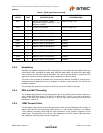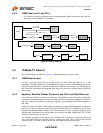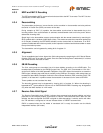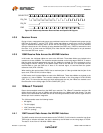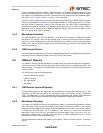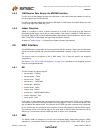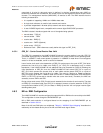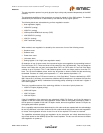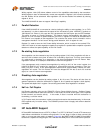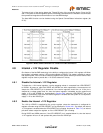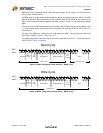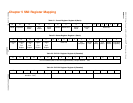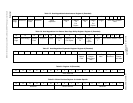
MII/RMII 10/100 Ethernet Transceiver with HP Auto-MDIX and flexPWR
®
Technology in a Small Footprint
Datasheet
SMSC LAN8710/LAN8710i 29 Revision 1.0 (04-15-09)
DATASHEET
The auto-negotiation protocol is a purely physical layer activity and proceeds independently of the MAC
controller.
The advertised capabilities of the transceiver are stored in register 4 of the SMI registers. The default
advertised by the transceiver is determined by user-defined on-chip signal options.
The following blocks are activated during an Auto-negotiation session:
Auto-negotiation (digital)
100M ADC (analog)
100M PLL (analog)
100M equalizer/BLW/clock recovery (DSP)
10M SQUELCH (analog)
10M PLL (analog)
10M Transmitter (analog)
When enabled, auto-negotiation is started by the occurrence of one of the following events:
Hardware reset
Software reset
Power-down reset
Link status down
Setting register 0, bit 9 high (auto-negotiation restart)
On detection of one of these events, the transceiver begins auto-negotiation by transmitting bursts of
Fast Link Pulses (FLP). These are bursts of link pulses from the 10M transmitter. They are shaped as
Normal Link Pulses and can pass uncorrupted down CAT-3 or CAT-5 cable. A Fast Link Pulse Burst
consists of up to 33 pulses. The 17 odd-numbered pulses, which are always present, frame the FLP
burst. The 16 even-numbered pulses, which may be present or absent, contain the data word being
transmitted. Presence of a data pulse represents a “1”, while absence represents a “0”.
The data transmitted by an FLP burst is known as a “Link Code Word.” These are defined fully in IEEE
802.3 clause 28. In summary, the transceiver advertises 802.3 compliance in its selector field (the first
5 bits of the Link Code Word). It advertises its technology ability according to the bits set in register 4
of the SMI registers.
There are 4 possible matches of the technology abilities. In the order of priority these are:
100M Full Duplex (Highest priority)
100M Half Duplex
10M Full Duplex
10M Half Duplex
If the full capabilities of the transceiver are advertised (100M, Full Duplex), and if the link partner is
capable of 10M and 100M, then auto-negotiation selects 100M as the highest performance mode. If
the link partner is capable of Half and Full duplex modes, then auto-negotiation selects Full Duplex as
the highest performance operation.
Once a capability match has been determined, the link code words are repeated with the acknowledge
bit set. Any difference in the main content of the link code words at this time will cause auto-negotiation
to re-start. Auto-negotiation will also re-start if not all of the required FLP bursts are received.
The capabilities advertised during auto-negotiation by the transceiver are initially determined by the
logic levels latched on the MODE[2:0] bus after reset completes. This bus can also be used to disable
auto-negotiation on power-up.



